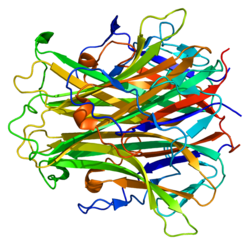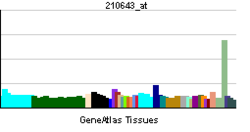RANKL:修订间差异
(没有差异)
|
2013年12月23日 (一) 11:24的版本
| 此條目目前正依照en:RANKL上的内容进行翻译。 (2013年12月23日) |
核因子κ-B配體受體致活劑(Receptor activator of nuclear factor kappa-B ligand,RANKL)是一種在人體中由「TNFSF基因」轉譯出來的蛋白質[1][2]。
RANKL在骨骼的新陳代謝方面,扮演著相當重要的角色。他是造骨細胞(osteoblast)膜上的一種膜蛋白(又被稱為CD254),可以活化蝕骨細胞,會加速蝕骨細胞破壞骨質並被吸收,為骨質更新的重要一環。
Osteoclastic activity is triggered via the osteoblasts' surface-bound RANKL activating the osteoclasts' surface-bound receptor activator of nuclear factor kappa-B (RANK).
RANKL的其他別名還有:「腫瘤壞死因子配體超家族成員11」(tumor necrosis factor ligand superfamily member 11,TNFSF11)、「腫瘤壞死因子相關誘導細胞因子」(TNF-related activation-induced cytokine,TRANCE)、「蝕骨細胞抑制因子配體」(osteoprotegerin ligand,OPGL)或蝕骨細胞分化因子(osteoclast differentiation factor,ODF)。
功能
RANKL is a member of the tumor necrosis factor (TNF) cytokine family which is a ligand for osteoprotegerin and functions as a key factor for osteoclast differentiation and activation. RANKL also has a function in the immune system, where it is expressed by T helper cells and is thought to be involved in dendritic cell maturation. This protein was shown to be a dendritic cell survival factor and is involved in the regulation of T cell-dependent immune response. T cell activation was reported to induce expression of this gene and lead to an increase of osteoclastogenesis and bone loss. This protein was shown to activate antiapoptotic kinase AKT/PKB through a signaling complex involving SRC kinase and tumor necrosis factor receptor-associated factor 6 (TRAF6), which indicated this protein may have a role in the regulation of cell apoptosis.[3]
動物模型
Targeted disruption of the related gene in mice led to severe osteopetrosis and a lack of osteoclasts. The deficient mice exhibited defects in early differentiation of T and B lymphocytes, and failed to form lobulo-alveolar mammary structures during pregnancy.[3]
臨床上的重要性
骨骼
Overproduction of RANKL is implicated in a variety of degenerative bone diseases, such as rheumatoid arthritis and psoriatic arthritis. The first FDA-approved RANKL inhibitor was denosumab (to treat osteoporosis in post menopausal women).
乳癌
Treatment with medroxyprogesterone acetate (MPA), a synthetic progestin that is used in birth control pills and hormone replacement therapy, is associated with an increased risk of developing breast cancer. MPA causes a substantial induction of RANKL in mammary-gland epithelial cells while deletion of RANKL decreases the incidence MPA-induced breast cancer. Hence inhibition of RANKL has potential for the prevention and treatment of breast cancer.[4][5]
參見
參考文獻
- ^ Wong BR, Rho J, Arron J, Robinson E, Orlinick J, Chao M, Kalachikov S, Cayani E, Bartlett FS, Frankel WN, Lee SY, Choi Y. TRANCE is a novel ligand of the tumor necrosis factor receptor family that activates c-Jun N-terminal kinase in T cells. J. Biol. Chem. 1997, 272 (40): 25190–4. PMID 9312132. doi:10.1074/jbc.272.40.25190. 已忽略未知参数
|month=(建议使用|date=) (帮助) - ^ Anderson DM, Maraskovsky E, Billingsley WL, Dougall WC, Tometsko ME, Roux ER, Teepe MC, DuBose RF, Cosman D, Galibert L. A homologue of the TNF receptor and its ligand enhance T-cell growth and dendritic-cell function. Nature. 1997, 390 (6656): 175–9. PMID 9367155. doi:10.1038/36593. 已忽略未知参数
|month=(建议使用|date=) (帮助) - ^ 3.0 3.1 Entrez Gene: TNFSF11 tumor necrosis factor (ligand) superfamily, member 11.
- ^ Schramek D, Leibbrandt A, Sigl V, Kenner L, Pospisilik JA, Lee HJ, Hanada R, Joshi PA, Aliprantis A, Glimcher L, Pasparakis M, Khokha R, Ormandy CJ, Widschwendter M, Schett G, Penninger JM. Osteoclast differentiation factor RANKL controls development of progestin-driven mammary cancer. Nature. 2010, 468 (7320): 98–102. PMID 20881962. doi:10.1038/nature09387. 已忽略未知参数
|month=(建议使用|date=) (帮助) - ^ Gonzalez-Suarez E, Jacob AP, Jones J, Miller R, Roudier-Meyer MP, Erwert R, Pinkas J, Branstetter D, Dougall WC. RANK ligand mediates progestin-induced mammary epithelial proliferation and carcinogenesis. Nature. 2010, 468 (7320): 103–7. PMID 20881963. doi:10.1038/nature09495. 已忽略未知参数
|month=(建议使用|date=) (帮助)
延伸閱讀
- Whyte M. The long and the short of bone therapy. N Engl J Med. 2006, 354 (8): 860–3. PMID 16495400. doi:10.1056/NEJMe068003. link
- Buckley KA, Fraser WD. Receptor activator for nuclear factor kappaB ligand and osteoprotegerin: regulators of bone physiology and immune responses/potential therapeutic agents and biochemical markers.. Ann. Clin. Biochem. 2003, 39 (Pt 6): 551–6. PMID 12564836. doi:10.1258/000456302760413324.
- Jeffcoate W. Vascular calcification and osteolysis in diabetic neuropathy-is RANK-L the missing link?. Diabetologia. 2005, 47 (9): 1488–92. PMID 15322748. doi:10.1007/s00125-004-1477-5.
- Collin-Osdoby P. Regulation of vascular calcification by osteoclast regulatory factors RANKL and osteoprotegerin.. Circ. Res. 2005, 95 (11): 1046–57. PMID 15564564. doi:10.1161/01.RES.0000149165.99974.12.
- Whyte MP, Mumm S. Heritable disorders of the RANKL/OPG/RANK signaling pathway.. Journal of musculoskeletal & neuronal interactions. 2005, 4 (3): 254–67. PMID 15615493.
- Clohisy DR, Mantyh PW. Bone cancer pain and the role of RANKL/OPG.. Journal of musculoskeletal & neuronal interactions. 2005, 4 (3): 293–300. PMID 15615497.
- Anandarajah AP, Schwarz EM. Anti-RANKL therapy for inflammatory bone disorders: Mechanisms and potential clinical applications.. J. Cell. Biochem. 2006, 97 (2): 226–32. PMID 16240334. doi:10.1002/jcb.20674.
- Baud'huin M, Duplomb L, Ruiz Velasco C; et al. Key roles of the OPG-RANK-RANKL system in bone oncology.. Expert Rev Anticancer Ther. 2007, 7 (2): 221–32. PMID 17288531. doi:10.1586/14737140.7.2.221.
- Yogo K, Ishida-Kitagawa N, Takeya T. Negative autoregulation of RANKL and c-Src signaling in osteoclasts.. J. Bone Miner. Metab. 2007, 25 (4): 205–10. PMID 17593489. doi:10.1007/s00774-007-0751-2.
- Boyce BF, Xing L. Biology of RANK, RANKL, and osteoprotegerin.. Arthritis Res. Ther. 2007,. 9 Suppl 1: S1. PMC 1924516
 . PMID 17634140. doi:10.1186/ar2165.
. PMID 17634140. doi:10.1186/ar2165. - McClung M. Role of RANKL inhibition in osteoporosis.. Arthritis Res. Ther. 2007,. 9 Suppl 1: S3. PMC 1924518
 . PMID 17634142. doi:10.1186/ar2167.
. PMID 17634142. doi:10.1186/ar2167.
外部連結
| |||||||||||||||||||||||||||||||||||||
| |||||||||||||||||||||||||||||||||||||||||||||||||||||||||||||||||||||||||||||||||||||||||||||||||||||||||||||||



